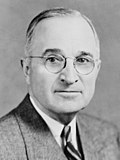| | |||||||||||||||||||||||||||||||||||||
November 2, 1948 | |||||||||||||||||||||||||||||||||||||
| Turnout | 65.0% [1] | ||||||||||||||||||||||||||||||||||||
|---|---|---|---|---|---|---|---|---|---|---|---|---|---|---|---|---|---|---|---|---|---|---|---|---|---|---|---|---|---|---|---|---|---|---|---|---|---|
| |||||||||||||||||||||||||||||||||||||
 County results
| |||||||||||||||||||||||||||||||||||||
| |||||||||||||||||||||||||||||||||||||
| Elections in New York |
|---|
 |
The 1948 United States presidential election in New York took place on November 2, 1948. All contemporary 48 states were part of the 1948 United States presidential election. Voters chose 47 electors to the Electoral College, which selected the president and vice president.
Contents
New York was won by local Republican Governor Thomas E. Dewey, who was running against incumbent Democratic President Harry S. Truman. Dewey ran with California Governor Earl Warren for vice president, and Truman ran with Kentucky Senator Alben W. Barkley. Dewey took 45.99% of the vote to Truman's 45.01%, a margin of 0.98%. Progressive Party candidate Henry A. Wallace, a former Democratic Vice President who ran to the left of Truman and was nominated by the local American Labor Party, finished a strong third, with 8.25%.
New York weighed in for this election as 1% more third-party than the national average, and less Democratic and Republican than the national average, despite New York being Governor Dewey's home state. The presidential election of 1948 was a very multi-partisan election for New York, with more than nine percent of the people who voted doing so for third parties. [2] In typical form for the time, the highly populated urban centers of New York City, Buffalo, and Albany, voted primarily Democratic, while most of the smaller counties in New York turned out for Dewey as the Republican candidate.
Henry Wallace's relatively strong third party support as a Progressive candidate was concentrated in the New York City area; in the three Democratic boroughs of New York City (Manhattan, Brooklyn, and the Bronx), Wallace took percentages in the double digits. Wallace's vote splitting among left-leaning voters in New York City contributed to Dewey narrowly defeating Truman in the state, after New York had voted Democratic for Franklin D. Roosevelt—himself a former governor and favorite son—in the preceding four elections. Although Truman lost the state, he did pick up Oneida County, which Roosevelt had lost in all his four elections and which had last been won for the Democrats by Woodrow Wilson in the three-way 1912 election, and before that by Grover Cleveland in 1884.
Dewey won the election in New York by a narrow margin of less than one percentage point, despite it being his home state, and more importantly despite not facing a local opponent like he had four years earlier when he was defeated by the then-incumbent President (and former New York Governor) Franklin D. Roosevelt.
For the first presidential election since 1916, New York did not back the winning candidate. This was also the first election wherein the losing major-party candidate carried their home state since Charles Evans Hughes carried New York in 1916, and the only instance between that election and 1960. Alongside Strom Thurmond’s win in South Carolina, this was the first time since Robert M. La Follette carried Wisconsin in 1924 that any losing candidate had done so.
Truman is the last Democrat to win a presidential election without winning New York, and Dewey's victory made him the third and final Republican presidential candidate to win New York without winning the election, the first being John C. Frémont in 1856 and the second Hughes in 1916. Dewey's victory was the first of three consecutive Republican victories in the state, as New York would not vote Democratic again until John F. Kennedy won the state in 1960.



